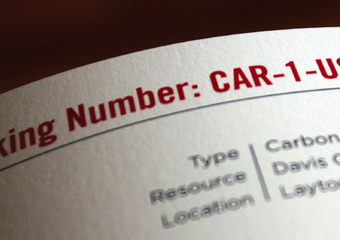WHAT ARE REC TRACKING SYSTEMS?
There are nine electronic REC tracking systems in the U.S. which exist to provide the most transparent assurance that RECs are based on actual metered electric production at renewable energy projects, and that RECs are not double counted. [The tracking systems are: WREGIS; M-RETS; Texas REC; PJM-EIS; NEPOOL GIS; MI-RECS; NC-RETS; North American Renewable Registry (NARR); and NVTREC.
HOW DO THEY WORK?
These tracking systems are essentially “bank accounts” for RECs, and generally all work in the same way: Renewable energy projects register with the system by providing basic information such as their size, location, owner name, and resource type (e.g. wind, solar, biomass). As the projects operate, a qualified reporting entity reports to the tracking system the actual metered electric generation by the project. The tracking system then creates and issues RECs – each with a unique serial number – to the project’s tracking system account. After the RECs are issued, they can either be transferred to another entity’s account – for example a REC purchaser or aggregator. Or the RECs can be transferred to a retirement account, meaning the RECs have been used for a purpose and can no longer be transferred or used for another purpose. For example, utilities retire RECs to demonstrate compliance with renewable portfolio laws. REC providers like OneEnergy Renewables retire RECs to fulfill retail REC deliveries to our customers.
In essence, the REC tracking systems provide a means to follow a REC from its creation, through intermediary purchasers, to its retirement. The systems are not financial trading platforms – they exist only to provide a delivery mechanism and for tracking REC ownership and use.
WHY WERE THESE SYSTEMS CREATED?
REC tracking systems were principally created to provide a transparent and accurate way for regulators (such as state public utility commissions) to verify utility compliance with state renewable portfolio requirements. The systems simultaneously can provide the same type of “compliance-grade” transparency and accuracy to the voluntary green power market.
In the vast majority of states with renewable portfolio laws (about 29 states in all), state law requires that utilities and power marketers use the applicable REC tracking system when demonstrating compliance with the law.
WHO IS IN CHARGE OF THE TRACKING SYSTEMS?
Each is managed by a different entity, but in generally they are run by independent grid operators such as PJM; grid reliability organizations such as the Western Electric Coordinating Council; or regulators such as the Texas Public Utility Commission.
AREN’T ALL RECS IN THESE TRACKING SYSTEMS?
No. Many RECs change hands solely via “attestations,” especially projects in the southeast and southern Midwest (Oklahoma, Kansas, and Missouri). Attestations are generally two or three page forms which identify the project, the REC seller and recipient, and the gross quantity of RECs being transferred. The attestations also include a list of statements that the transferor agrees to, for example that the transferor has not used or sold the RECs more than once.
DOES THE GREEN-E ENERGY PROGRAM REQUIRE USE OF REC TRACKING SYSTEMS BY GREEN-E CERTIFIED SELLERS?
No. Green-e Energy certified REC sellers can source RECs either from projects that are tracked, or from projects that deliver RECs via attestations.
DO RECS IN TRACKING SYSTEMS PROVIDE A HIGHER LEVEL OF TRANSPARENCY AND QUALITY THAN OTHERS?
Absolutely. RECs in tracking systems are compliance grade, providing an auditable trace of each REC’s history back to the generator. Each REC in a tracking system has its own serial number generated by the system, allowing OneEnergy Renewables to identify the exact RECs retired on our customers’ behalf. In addition, there has been a “second set of eyes” on the actual reported electric generation from the project, which must equal the number of RECs issued to the project’s tracking system account. In some cases, the tracking system will require additional information from the project owner if the amount of generation reported in for the project appears to be unusually high. The project owner and the qualified reporting entity both have enforceable contractual relationships with the tracking system to ensure compliance with the system’s rules.
Conversely, RECs outside of tracking systems do not have an equally traceable history. The owners of these projects simply self-report the gross quantity of RECs being transferred from each month or quarter of project generation. In most cases the project owner will not have any contractual relationship with a certification entity like Green-e that might allow the certifier to audit the generator. While the likelihood of fraudulent or erroneous REC quantities is likely small, REC tracking systems erase any doubts about whether RECs are based on actual generation, and whether the RECs are double-counted or double-claimed.
